If any one New England race can be described as “passing Conanicut Island’s Beavertail Light twice”, it’s the Jamestown Double Beaver and this year’s Ride the Bull. My math may be off a bit. This was to be the 8th to 12th running (look, numbers just aren’t my thing) of the Quintuple Beaver (see?) – a storied race in which paddlers contend with the worst that Narragansett Bay can throw at them. Unpredictable currents and winds. Incessant boat traffic. Hidden rocks. Jazz. Jazz, for pity’s sake! With a mild north-easterly wind forecast, at least conditions would be favorable. We’d never be downwind of the festival in Newport.
With four weekends of consecutive races, we need to pace ourselves on the race reports. Just remember – a month from now we’ll be past this dark time. To help us along, I’ll try to keep the reports tight and concise. That won’t actually happen, of course, so you’ll just have to buckle in and bear down.
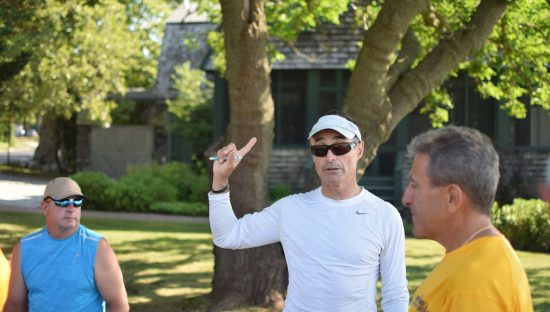
After last year’s incident, Tim was adamant that simply carrying pants on your boat would no longer be sufficient. They must be worn. “On your legs!” he hollered after us as we ran bare-assed to our boats.
Over the past few years, race organizer Tim Dwyer has grown increasingly obsessed about running the Double Beaver out past the Beavertail bell buoy to turn on Whale Rock – a low-lying island stripped clean of its lighthouse by the Great New England Hurricane of 1938 (this was back before storms had fanciful names like “Andrew” or “Sweet-Talkin’ Bess”). Like Ahab, however, the Whale has eluded him. Whether it was Borys Markin turning prematurely on buoy G3 or impending thunderstorms shortening the course, we never quite achieved Tim’s goal. Legend has it that only one person had ever seen the Whale up close, but the name of that stalwart soul is long forgotten (no need to fact check this one, editor). Tim was convinced that this was the year he’d encircle the beast, although rechristening his ski Pequod and constantly referring to Wesley as “Queequechols” seemed to be tempting fate.
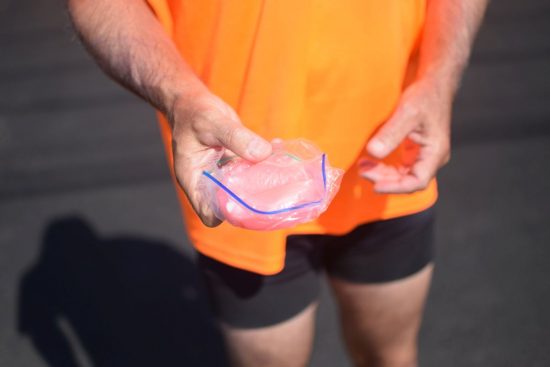
“The first one is free,” said Chris Sherwood with a sly grin. I’m still not sure exactly what it was, but it tasted like something Tim Hudyncia might enjoy.
After a brief and maniacal captains’ meeting, we launched our fleet of 16 skis and an outrigger. Given the mild forecast, flatwater specialist Mike Dostal seemed particularly threatening – and not just because when nobody was looking, he glowered at me while slowly drawing a finger across his throat. Eric Costanzo was also intimidating, having brought some New Jersey muscle with him to remind me how things stood (him on the top step of the podium, me somewhere else).
Armed with sophisticated computer models of tidal eddies in Jamestown Bay supplemented by years’ worth of empirical records collected by his field team, Tim had been able to pinpoint where mats of surface weeds were likely to accumulate. And then set the starting line in the heart of one such archipelago of floating vegetation. While some paddlers questioned this choice, I was glad to be able to stretch my legs with a brisk stroll before the race. Unfortunately, we’ll be unable to utilize the same weed field for next week’s Battle of the Bay start since most of the flotsam was dragged out to the open ocean by inconsiderate Double Beaver paddlers.
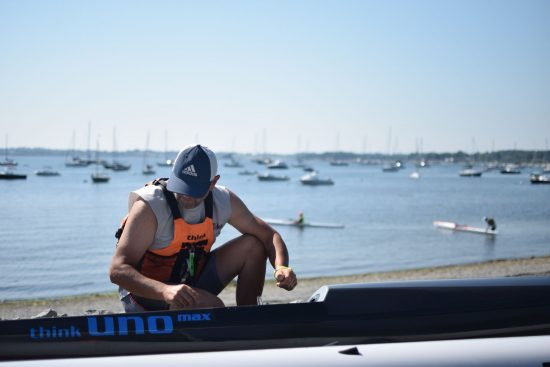
Jan makes a few last minute adjustments to his attitude.
We tried a “shock start” approach in which we’d be given a one minute warning, at any point after which outrigger paddler Carol Choi could choose to jump in the water to clear her rudder, thus signalling Tim to immediately start the race. Given how effective this procedure was in preventing anyone from getting an unfair jump, here’s hoping we can convince Carol to attend every race.
With moored boats dotting the harbor, we were quickly pachinko-ed into separate streams. After a couple of minutes I had worked my way past Wesley, Joe Shaw, and Matt Nunnally. With an outgoing tide, I figured an outside line to House on the Rock would be the quickest route. Having been fooled by the inscrutable currents of Narragansett Bay in the past, I was relieved to see Eric corroborating my preferred line several boat lengths ahead. Sure, we might both be mistaken, but it’s a lot easier to maintain conviction in the face of contrary evidence when you have a like-minded zealot. After working my way up to Eric (and exchanging our secret hand signal, of course), I pulled ahead.

Bob gets a little sensitive when you question why Rhode Island was the last colony to ratify the Constitution.
On a slightly more inside line, Mike had made a strong start and easily seized the overall lead. Moving across the harbor, however, I managed to close the gap such that when our paths merged a mile into the race, we were even. You may recall that way back in the previous paragraph I had thought that the outside line was superior, but to give myself an ego boost, I rapidly reversed that sentiment (one of the advantages of zealotry – no reason to be tied down by logic or consistency). Just like that, I had now caught Mike despite the disadvantage of taking the inferior route!
Before the race, Mike had explained the reason behind the crazy patchwork of duct tape that covered parts of his V12. While staying on the Isles of Shoals, a freak storm had lifted his ski from the ground and tossed it along the rocky terrain, cracking it in several places. Let’s ignore the imprudence of not properly securing one’s boat. And also look past the questionable judgment in making key structural repairs using tape. Mike’s real blunder here was the complete lack of imagination he showed in failing to embellish the story. Maybe he pitch-poled during a treacherous surf landing. Or was hit by a lobster boat in heavy fog. Heck, I’d have even bought a giant squid attack. Our small lives need more excitement than the truth can supply (uh, this blog excepted, of course). Ski blown away on land? Please. That’s like me telling you this scar I have on my side came from a childhood fall. Rather than from a squid beak.
Approaching the rocks that guard the strait between Bull Point and the House on the Rock, I managed to catch a few small runners to put a boat length between me and Mike. As we turned the point and headed into unprotected waters, I watched him drifting in and out of my periphery – never more than a couple of boat lengths back. Where were the unsettled conditions we’ve come to expect in Narragansett Bay? I’m all for a level playing field. Just not literally. I’d need things to slant my way to pull free. Fortunately, a large boat wake eventually provided the edge I’d been waiting for – knocking Mike over (ostensibly out of view and earshot, meaning that I needn’t even slow to disingenuously offer assistance). As the day wore on, the increasing lumpiness of the bay provided me with some measure of insurance against further attacks from Mike.
On paper, the tide had looked ideal. The race straddled slack tide, meaning we’d be gently nudged out to Whale Rock on the outgoing current, then shepherded home on the newly turned tide. Prior to the race, however, oceanographer Chris Sherwood had said that we probably “wouldn’t get any help on the way back” (in an ominous tone that made me wonder if I should pack some extra provisions). Despite being the only person with any legitimate credentials in this area (I’m 95% sure that Tim Hudyncia just made that “Master of Tides” badge himself), most of us chose to ignore his dire warning. Passing by the Beavertail can, however, I had to concede that Dr. Sherwood’s years of graduate training had finally paid off. Ignoring the fact that it was supposed to be slackening in preparation for coming about, the outgoing tide was still lending us more than a kilometer per hour. Presumably it would be asking us to repay that loan on the return trip.
After turning on Whale Rock (with its cryptic and faded “MB ’13” graffiti), I dutifully started contributing 12% of my velocity back to the sea. Given that I was also tithing another few percent to the headwind and making the occasional balloon payments on some lingering Blackburn debt, I was barely able to scrape by. I understood from a logical perspective that hugging the coastline would provide some relief from the current and wind (an onshore tax shelter?), but my lizard brain kept pulling me back onto the straight line home. As in life more generally, I made a half-hearted show of doing the right thing before succumbing to my baser instincts.
The crawl back to the House on the Rock was enlivened by an increasingly disordered jumble of boat wakes. This gave me a chance to practice what I call my “scuttle stroke” – a rapid, short, horizontal stroke designed to ferry me safely through rough patches. Although not strictly required (as it is in the related “scamper stroke”), I like to make mouth-smacking critter noises in time with my cadence. I’ve also found that a modest dose of panic helps in keeping your paddle nimble. Regardless of whether it was because of, or in spite of, the scuttle, I made it back into the relative calm of Jamestown Harbor and scored my first Double Beaver victory.
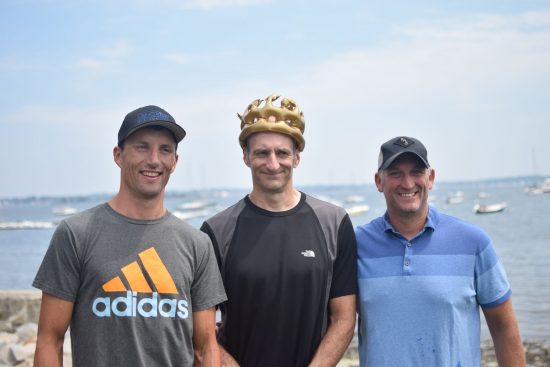
Heavy is the head that wears the crown. Unless you’re wearing the new German-engineered, hydrogen-filled Hindenkrone! As the tagline says, “What could possibly go wrong?”
Despite paddling in unfamiliar conditions on a less-than-forgiving V12, Mike managed to hold on for second place over Eric (who was on a downright-unforgiving V14). Tim finally got the better of Whale Rock with a strong 4th place finish (and all limbs intact), while Joe Shaw took 5th. Mary Beth seized the women’s title, throttled it, then ripped at its carcass with her teeth. I’m not sure what got into her.
As you ocean paddlers know, our program to inculcate a sense of inferiority and shame in flatwater paddlers has been a great success. Our only hope against these speed demons is to keep them apprehensive about paddling in the ocean. By consistently downplaying conditions when these unfortunates are within earshot – for example, referring to Ride the Bull as a “walk in the park” or the Blackburn as “dead calm” – we’ve shattered their confidence. After the Double Beaver, Mike was practically begging us to admit that the course wasn’t flat, but I’m proud to say that we maintained a unified front. None of us could remember such mill pond-like conditions. Kirk Olsen’s claim that he dozed off a few times during the race was a particularly disheartening touch.
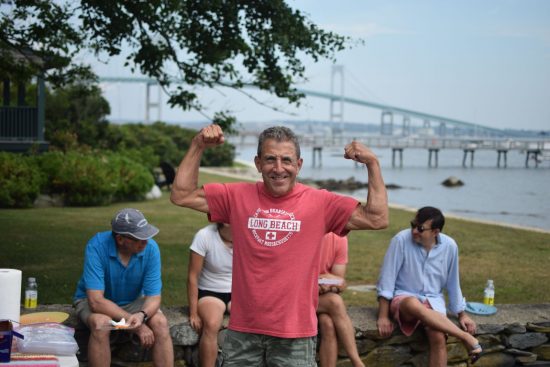
If Bob were twenty years younger, you wouldn’t dare mess with him. Or twenty years older, now that I think of it.
Once all of the paddlers had been accounted for (give or take), we settled in to attack lunch. Several of us contracted diabetes just from looking at the mountainous platter of cookies. Keeping with tradition (his own, but still), Tim provided the top five with gag gifts that wouldn’t be out of place at a six year old’s birthday party – perhaps a little advanced for our crew, but we’ll grow into them. Thanks to Tim for another exciting Double Beaver. And to the Finn triplets for being everywhere along the course taking photos.
Hold on a second, paddler. You’re not escaping Rhode Island that easy. You’ll have to fight your way out via the Battle of the Bay this Saturday. Register at PaddleGuru. If you survive the tussle, don’t leave until after Sean Rice’s beginner/intermediate clinic in the afternoon. Register at Paddle Life.
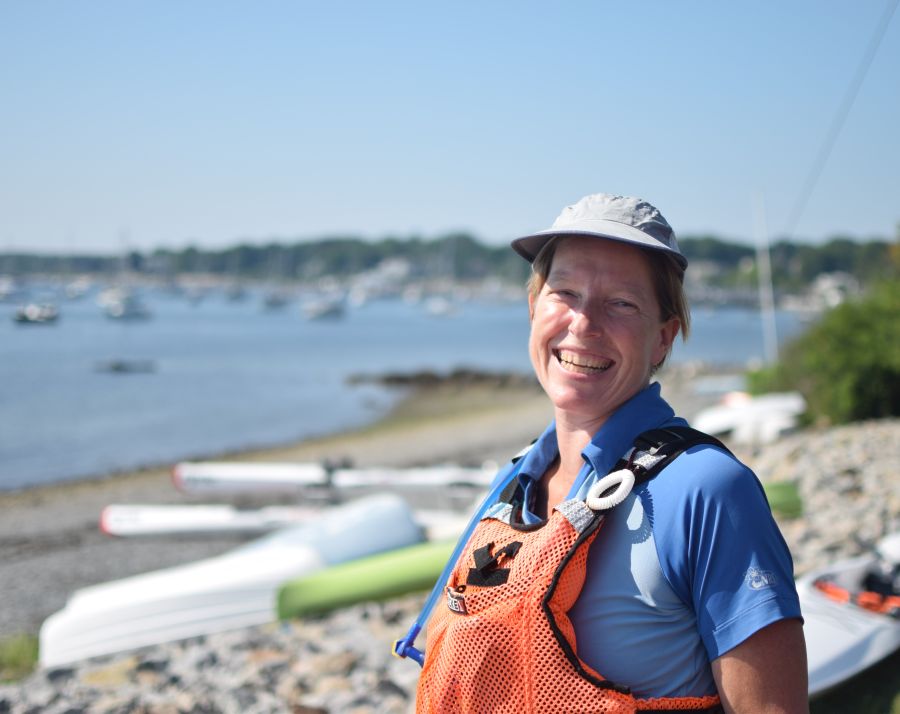
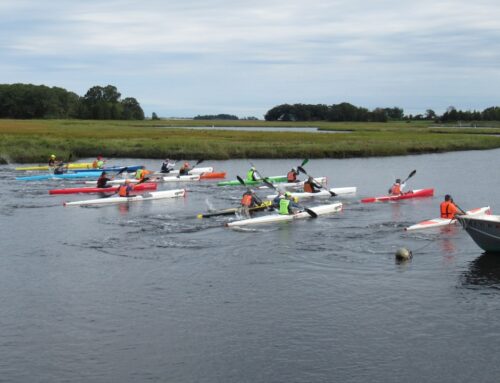
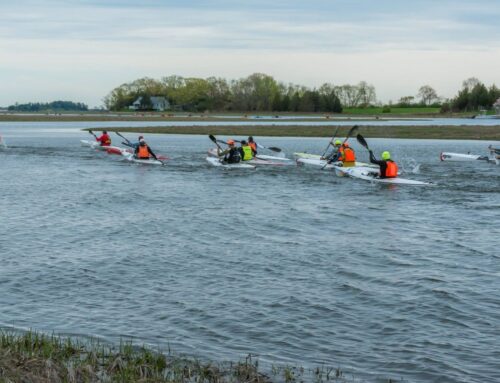
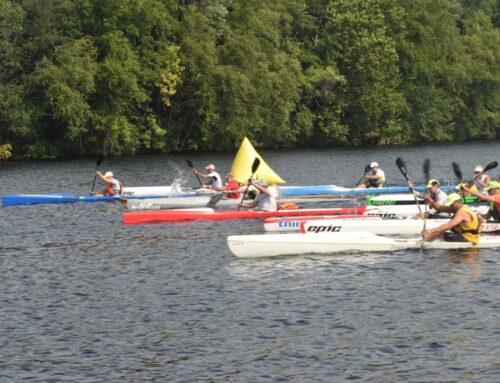
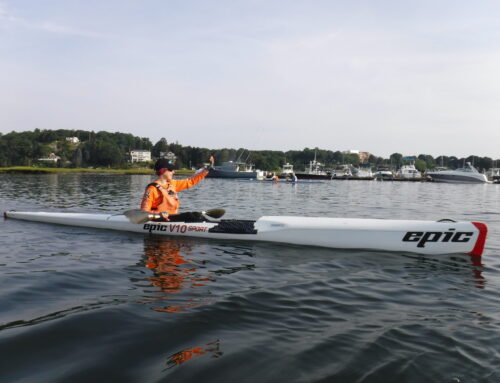
Leave A Comment
You must be logged in to post a comment.